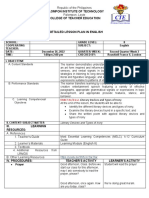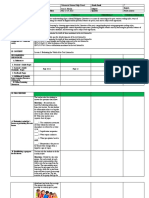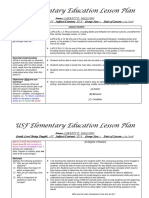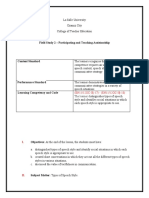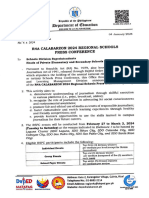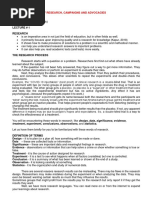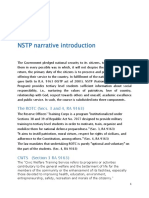Linear and Non Linear LP
Uploaded by
Perry Amatorio Delos Reyes Jr.Linear and Non Linear LP
Uploaded by
Perry Amatorio Delos Reyes Jr.lOMoARcPSD|15548046
Linear and non-linear LP
Secondary Education (La Salle University - Ozamiz)
Studocu is not sponsored or endorsed by any college or university
Downloaded by Perry Delos Reyes Jr. (perry.delosreyesjr@deped.gov.ph)
lOMoARcPSD|15548046
La Salle University
College of Teacher Education
Lesson Plan
A. Content The learner demonstrates understanding of: Philippine
Standards literature during the Period of Apprenticeship as a means of
examining conflicts; various purposeful listening and
viewing strategies; difference between literal and figurative
language; ways to extract and condense information based
on library sources; verbal and non-verbal cues in oral
communication; and types of phrases, clauses, and
sentences.
B. Performance The learner transfers learning by: resolving conflicts
Standards presented in literary selections; using tools and mechanisms
in locating library resources; extracting information and
noting details from texts to write a précis, summary, or
paraphrase; distinguishing between and using literal and
figurative language and verbal and non-verbal cues; use
phrases, clauses, and sentences meaningfully and
appropriately.
C. Learning Transcode information from linear to non-linear texts and vice-
Competency and versa. (EN8RC-IIe-11)
Code:
Learning Objectives:
At the end of the lesson, the students will be able to:
Downloaded by Perry Delos Reyes Jr. (perry.delosreyesjr@deped.gov.ph)
lOMoARcPSD|15548046
a. transcode information from linear to non-linear texts and vice-versa
b. differentiate linear and non-linear texts; and
c. explain why stories and other examples of linear texts should be read
from beginning to the end.
II. Subject Matter: Linear and Non-linear Texts
Reference/s:
Pivot 4A Learner’s Material pp. 33-36
Gementiza, K. (2018, September 27). Linear and Non linear texts (English 9). Slideshare.
https://www.slideshare.net/klam20/linear-and-non-linear-texts-english-9
Hasa. (2018, June 18). Difference between linear and nonlinear text. Compare the Difference
Between Similar Terms.
https://www.differencebetween.com/difference-between-linear-and-nonlinear-
text/
c. Materials: PowerPoint Presentation, Quizziz , Jamboard, (Digital Tool)
III. Procedure: 4A’s Method
Teacher’s Activity Students’ Activity
A. Activity
Good Morning, class! Good Morning, Miss!
I believe it is my first time teaching here in your
class. Thus, allow me to introduce myself. I am Ms.
Glorry May J. Baludo, your English teacher this
morning, and for your convenience class, you may
call me Ms. May
Downloaded by Perry Delos Reyes Jr. (perry.delosreyesjr@deped.gov.ph)
lOMoARcPSD|15548046
Let us start the day with a prayer.
Choose a color from the color wheel that best
represents how you are feeling this morning.
Class, whatever you are feeling today is valid. We
have to acknowledge what we feel and try our best to
make ourselves better especially in this trying times.
As with your other teachers, I also imposed my own
online classroom rules that you are strictly required
to follow. These rules are M-O-R. M stands for
MUTE your microphone unless told otherwise. O is
for OPEN your camera when you are going to
answer questions and raise concerns or as much as
possible. If you cannot open your camera inform me
ahead. Lastly, R stands for RAISE, press the raise
hand button if you want to volunteer in answering
questions or in raising concerns. Yes, Miss.
Am I making sense here, class?
1. Review
Alright! Last meeting, we discussed about the three
rules of Subject-Verb Agreement. For me to test your
understanding of the previous discussion, let us have
a short review.
Kindly go to Quizziz and enter the code posted in the
chat box and on the screen.
Downloaded by Perry Delos Reyes Jr. (perry.delosreyesjr@deped.gov.ph)
lOMoARcPSD|15548046
Directions: Read and analyze each item. Choose the
correct form of the verb that corresponds with the
subject in each sentence.
Example: Shiela (dance/dances) to the music.
Answer: Shiela dances to the music.
1. My mother (is/are) a great cook.
2. Jackson, including his younger sister (is/are) going Answers
on a vacation. 1. My mother is a great cook.
3. The collection of antique vases was/were 2. Jackson, including his younger
stolen yesterday. sister is going on a vacation.
4. Is/Are it okay to borrow your pen? 3.The collection of antique vases was
5. The houses is/are very expensive. stolen yesterday.
4. Is it okay to borrow your pen?
5. The houses are very expensive.
Very good! It shows that you have mastered the three
rules of Subject-Verb Agreement.
2. Motivation
Before we would formally start our discussion, let us
have a short activity.
Directions: Group the following pictures. Group A is
one group and the second is Group B.
Picture 1: Character Map
Answers
Downloaded by Perry Delos Reyes Jr. (perry.delosreyesjr@deped.gov.ph)
lOMoARcPSD|15548046
Group A: Picture 2 and 3
Group B: Picture 1 and 4
Picture 2: Story
Picture 3: Letter
Downloaded by Perry Delos Reyes Jr. (perry.delosreyesjr@deped.gov.ph)
lOMoARcPSD|15548046
Picture 4: Venn Diagram
Alright! Class, what is your basis in grouping the
pictures? The basis in grouping the pictures to
group them according to their
That is right! When we group something, we usually similarities.
group together those with commonalities.
Based on the groupings, how do you read text in
group 1? How about group 2?
The text in group 1 can be read freely.
It does no need to be read from the
beginning to the end. While for group
2 the text is read from beginning to the
Slendid! Did you know that if a text is read from the end.
begnning to the end is called linear text and text wich
are not read from the beginning to the end is called
non-linear text. Today, we will learn more about it.
Are you ready?
Yes, Miss
3. Statement of the Subject Matter and the Objectives
Before anything else, I want you to listen attentively
and participate actively because at the end of the
Downloaded by Perry Delos Reyes Jr. (perry.delosreyesjr@deped.gov.ph)
lOMoARcPSD|15548046
lesson you will be able to attain these following
objectives:
a. a. transcode information from linear to non-linear
texts and vice-versa
b. differentiate linear and non-linear texts; and
c. explain why stories and other examples of linear
texts should be read from beginning to the end.
Are the objectives clear, class?
Yes, Miss.
A. Activity
To formally start our new lesson this afternoon, let’s
have an activity entitled “List Me”.
Directions: List down examples of linear texts and
non-linear texts.
B. Analysis
At this moment, let us try to determine whether your
answers are correct in the activity “List Me”.
(Students do as told.)
Are all the examples of linear text listed correct
class?
Yes, Miss.
Why do you say so?
The examples of linear text listed are
correct because the text is read from
beginning to the end.
Very Good! How about the examples of non-linear
text are they correct? Why?
The examples of non-linear text listed
are also correct because the text is not
Downloaded by Perry Delos Reyes Jr. (perry.delosreyesjr@deped.gov.ph)
lOMoARcPSD|15548046
Great! Now based on the previous activities, let us read from the beginning to the end.
define linear and non-linear text.
What is Linear texts class? Linear texts are texts which are read
from beginning to the end.
How about non-linear texts?
Non-linear texts on the other hand, are
text which is not read from beginning
to the end.
That is correct! Linear texts, these are traditional
texts which can only be read from the beginning to
the end. On the other hand, non-linear text is the
opposite of linear text. It does not require a
sequential manner in when read.
Now class, what do you think is the outcome if linear
text is not read from the beginning to the end? Like
in reading a story, you will read starting in the
middle, then beginning and then the end, what will
happen? If a linear text is not read from the
beginning to the end, the reader will
not be able to understand it and they
will be confused.
Exactly! Linear text must be read from beginning to
the end for us to understand the idea of the text.
C. Abstraction
At this point, let us further examine linear text and
non-linear text.
Downloaded by Perry Delos Reyes Jr. (perry.delosreyesjr@deped.gov.ph)
lOMoARcPSD|15548046
LINEAR TEXT NON-LINEAR
TEXT
DEFINITION It refers to It refers to
traditional texts texts that do
that need to be not need to
read from be read from
beginning to beginning to
the end. the end.
READING There is only There are
PATH ONE reading multiple
path, which is reading paths.
decided by the They are
author. determined by
the reader.
EFFICIENCY It may take It does not
time to find the take time
information because it
readers are allows readers
searching for. to find more
information
efficiently.
EXAMPLES Novels, Tables, pie
poems, letters, charts, flow
textbooks, charts,
news reports, pictures,
essays diagrams,
character
maps,
sequence
charts
STEPS IN TRANSCODING LINEAR TO NON-
LINEAR TEXT AND VICE-VERSA
Downloaded by Perry Delos Reyes Jr. (perry.delosreyesjr@deped.gov.ph)
lOMoARcPSD|15548046
Step 1. Read and understand the source text to get its
main or central ideas.
Step 2. Extract important details to be included in the
visual presentation.
Step 3. Remember to words or phrases only.
Step 4. To be organized, classify information into Yes, Miss.
categories.
Step 5. Make sure to use the appropriate non-linear
text in presenting your information.
Is that clear, class? (Students do as told).
D. Application
To test your understanding of the topic, we will have
an activity entitled “Transcode Me”.
Directions: Transcode linear text to non-linear text
and vice-versa. Yes, Miss
The class will be divided into two groups. The class
are given 5 minutes to create a summary. This Yes, Miss.
activity is done through Jamboard.
Is that clear to you, class?
Shall we start now?
Downloaded by Perry Delos Reyes Jr. (perry.delosreyesjr@deped.gov.ph)
lOMoARcPSD|15548046
Group 1: The pie graph shows the family budget plan
of Mrs. Reyes. Transcode the pie graph into a short
paragraph.
Yes, Miss.
Group 2: Make a sequence chart based from this
paragraph.
What are you going to do if your clothes caught fire
during an emergency situation? Here are the things
you should do: First, stop where you are – moving or
running feeds air to the flames and worsens the fire.
Next, drop to the floor – if you stand up, the fire can Yes, Miss.
burn your face. Fold your arms high on your chest to
protect your face. Then, roll slowly on the floor or
ground, in a rug or blanket if you can. Afterwards, (Students do as told).
cool off as soon as possible with water for first- and
second-degree burns. Finally, to escape fire, get
down low and go.
https://www.edrawsoft.com/graphicorganizer/using-
sequence-chart-teaching.html
Excellent job! Let us give ourselves an amazing clap.
Begin!
Downloaded by Perry Delos Reyes Jr. (perry.delosreyesjr@deped.gov.ph)
lOMoARcPSD|15548046
IV. Evaluation
To test your understanding of the lesson, let us have our next activity. This activity is by group.
Although this is a group activity, you will be graded as a group and individually based on your
individual contributions.
Directions: Using a Venn Diagram, differentiate linear from non-linear text.
V. Assignment
For your assignment, just continue working with your assignments in the module posted by your
teacher.
Prepared by:
Glorry May J. Baludo, BSEd-English 4
Downloaded by Perry Delos Reyes Jr. (perry.delosreyesjr@deped.gov.ph)
You might also like
- papaliahd14_ppt_ch04_Accessible (2) (2)No ratings yetpapaliahd14_ppt_ch04_Accessible (2) (2)50 pages
- English: Quarter 4 - Module 5: Using Demonstrative Pronouns80% (20)English: Quarter 4 - Module 5: Using Demonstrative Pronouns30 pages
- 50 Questions For Finding Your Passion Purpose in Life PDF100% (1)50 Questions For Finding Your Passion Purpose in Life PDF12 pages
- Daily Lesson LOG School: Laon Elementary School Grade Level: FOURNo ratings yetDaily Lesson LOG School: Laon Elementary School Grade Level: FOUR4 pages
- Detailed Lesson Plan in Grade 9 Module 2 Q2No ratings yetDetailed Lesson Plan in Grade 9 Module 2 Q29 pages
- Level II Lesson Plan - CT Observation 2 - Small Group Ela ComprehensionNo ratings yetLevel II Lesson Plan - CT Observation 2 - Small Group Ela Comprehension11 pages
- 2023-2nd-DEMO-LESSON-PLAN-FAINA-RACHEL-JOI-CNo ratings yet2023-2nd-DEMO-LESSON-PLAN-FAINA-RACHEL-JOI-C10 pages
- DEMO SED 3204( DETAILED LESSON PLAN ON ENGLISH 7)No ratings yetDEMO SED 3204( DETAILED LESSON PLAN ON ENGLISH 7)17 pages
- DAILY LESSON PLAN.docx(jan.27,2025)docs.No ratings yetDAILY LESSON PLAN.docx(jan.27,2025)docs.6 pages
- My School: Where Is It? What Do You Think of It?No ratings yetMy School: Where Is It? What Do You Think of It?2 pages
- Lesson Script in English: National Reading ProgramNo ratings yetLesson Script in English: National Reading Program57 pages
- english-2-q3-mod7-identifying-major-point-and-keythemesNo ratings yetenglish-2-q3-mod7-identifying-major-point-and-keythemes17 pages
- Field Study 2 - Participating and Teaching Assistantship: Content StandardNo ratings yetField Study 2 - Participating and Teaching Assistantship: Content Standard18 pages
- Poetry Unit: Lesson Idea/Topic and Rational/RelevanceNo ratings yetPoetry Unit: Lesson Idea/Topic and Rational/Relevance19 pages
- Eedited2 DLP For Grammatical Expressions - English 10No ratings yetEedited2 DLP For Grammatical Expressions - English 1010 pages
- LE Q2 Week 8 Reading & Literacy Matatag - D2No ratings yetLE Q2 Week 8 Reading & Literacy Matatag - D211 pages
- Passed 1766-12-20MELCS Baguio Fact and OpinionNo ratings yetPassed 1766-12-20MELCS Baguio Fact and Opinion22 pages
- DIVISION OF BINAN 2023 DIVISION SCHOOLS PRESS CONFERENCE MATRIX Final2No ratings yetDIVISION OF BINAN 2023 DIVISION SCHOOLS PRESS CONFERENCE MATRIX Final21 page
- Moving Towards 21st Century English Language TeachingNo ratings yetMoving Towards 21st Century English Language Teaching6 pages
- Linguistic Participation in SL LearningNo ratings yetLinguistic Participation in SL Learning22 pages
- Sdo Cid f092 Results of Quarterly Assessment Mapeh 9No ratings yetSdo Cid f092 Results of Quarterly Assessment Mapeh 94 pages
- Student Industrial Attachment Report by Muthama David .M. S11/21490/14No ratings yetStudent Industrial Attachment Report by Muthama David .M. S11/21490/147 pages
- List of Teachers Spring - 2010 With Short Name and Telephone NumberNo ratings yetList of Teachers Spring - 2010 With Short Name and Telephone Number20 pages
- Decision Making in Service Industries A Practical Approach 1st Edition Javier Faulin (Editor) - Explore the complete ebook content with the fastest download100% (1)Decision Making in Service Industries A Practical Approach 1st Edition Javier Faulin (Editor) - Explore the complete ebook content with the fastest download56 pages
- Get Mastering Deputy Headship 2nd Edition Trevor Kerry free all chapters100% (1)Get Mastering Deputy Headship 2nd Edition Trevor Kerry free all chapters71 pages
- Lesson 1 - Academic Reading and WritingNo ratings yetLesson 1 - Academic Reading and Writing15 pages
- Asnt NDT Level Ii Certification Application: ASNT Identification Number Personal DataNo ratings yetAsnt NDT Level Ii Certification Application: ASNT Identification Number Personal Data10 pages
- What Are The Expected Tasks You Have Successfully Accomplished67% (18)What Are The Expected Tasks You Have Successfully Accomplished1 page
- Why Facilitating Progress Is Key To Employee Engagement 1687790031No ratings yetWhy Facilitating Progress Is Key To Employee Engagement 168779003127 pages
- (Magazine) The Biblical Archaeologist. Vol. 49. No 1No ratings yet(Magazine) The Biblical Archaeologist. Vol. 49. No 170 pages
- Majid Majeed Akbar: Objective: Professional ExperienceNo ratings yetMajid Majeed Akbar: Objective: Professional Experience5 pages
- COT DLP FILIPINO6 - ROMA-Wastong Paggamit NG Pang-Angkop at Pangatnig FINALNo ratings yetCOT DLP FILIPINO6 - ROMA-Wastong Paggamit NG Pang-Angkop at Pangatnig FINAL25 pages
- PDF Quick Access Reference for Writers 6th ed. Edition Lynn Quitman Troyka download100% (3)PDF Quick Access Reference for Writers 6th ed. Edition Lynn Quitman Troyka download71 pages
- Compréhension Et Interprétation: Deux Composantes Complémentaires de La Lecture LittéraireNo ratings yetCompréhension Et Interprétation: Deux Composantes Complémentaires de La Lecture Littéraire23 pages
- English: Quarter 4 - Module 5: Using Demonstrative PronounsEnglish: Quarter 4 - Module 5: Using Demonstrative Pronouns
- 50 Questions For Finding Your Passion Purpose in Life PDF50 Questions For Finding Your Passion Purpose in Life PDF
- Daily Lesson LOG School: Laon Elementary School Grade Level: FOURDaily Lesson LOG School: Laon Elementary School Grade Level: FOUR
- Level II Lesson Plan - CT Observation 2 - Small Group Ela ComprehensionLevel II Lesson Plan - CT Observation 2 - Small Group Ela Comprehension
- Lesson Script in English: National Reading ProgramLesson Script in English: National Reading Program
- english-2-q3-mod7-identifying-major-point-and-keythemesenglish-2-q3-mod7-identifying-major-point-and-keythemes
- Field Study 2 - Participating and Teaching Assistantship: Content StandardField Study 2 - Participating and Teaching Assistantship: Content Standard
- Poetry Unit: Lesson Idea/Topic and Rational/RelevancePoetry Unit: Lesson Idea/Topic and Rational/Relevance
- Eedited2 DLP For Grammatical Expressions - English 10Eedited2 DLP For Grammatical Expressions - English 10
- Teaching Text Features to Support ComprehensionFrom EverandTeaching Text Features to Support Comprehension
- DIVISION OF BINAN 2023 DIVISION SCHOOLS PRESS CONFERENCE MATRIX Final2DIVISION OF BINAN 2023 DIVISION SCHOOLS PRESS CONFERENCE MATRIX Final2
- Moving Towards 21st Century English Language TeachingMoving Towards 21st Century English Language Teaching
- Sdo Cid f092 Results of Quarterly Assessment Mapeh 9Sdo Cid f092 Results of Quarterly Assessment Mapeh 9
- Student Industrial Attachment Report by Muthama David .M. S11/21490/14Student Industrial Attachment Report by Muthama David .M. S11/21490/14
- List of Teachers Spring - 2010 With Short Name and Telephone NumberList of Teachers Spring - 2010 With Short Name and Telephone Number
- Decision Making in Service Industries A Practical Approach 1st Edition Javier Faulin (Editor) - Explore the complete ebook content with the fastest downloadDecision Making in Service Industries A Practical Approach 1st Edition Javier Faulin (Editor) - Explore the complete ebook content with the fastest download
- Get Mastering Deputy Headship 2nd Edition Trevor Kerry free all chaptersGet Mastering Deputy Headship 2nd Edition Trevor Kerry free all chapters
- Asnt NDT Level Ii Certification Application: ASNT Identification Number Personal DataAsnt NDT Level Ii Certification Application: ASNT Identification Number Personal Data
- What Are The Expected Tasks You Have Successfully AccomplishedWhat Are The Expected Tasks You Have Successfully Accomplished
- Why Facilitating Progress Is Key To Employee Engagement 1687790031Why Facilitating Progress Is Key To Employee Engagement 1687790031
- (Magazine) The Biblical Archaeologist. Vol. 49. No 1(Magazine) The Biblical Archaeologist. Vol. 49. No 1
- Majid Majeed Akbar: Objective: Professional ExperienceMajid Majeed Akbar: Objective: Professional Experience
- COT DLP FILIPINO6 - ROMA-Wastong Paggamit NG Pang-Angkop at Pangatnig FINALCOT DLP FILIPINO6 - ROMA-Wastong Paggamit NG Pang-Angkop at Pangatnig FINAL
- PDF Quick Access Reference for Writers 6th ed. Edition Lynn Quitman Troyka downloadPDF Quick Access Reference for Writers 6th ed. Edition Lynn Quitman Troyka download
- Compréhension Et Interprétation: Deux Composantes Complémentaires de La Lecture LittéraireCompréhension Et Interprétation: Deux Composantes Complémentaires de La Lecture Littéraire











